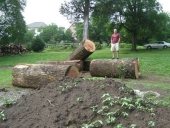








selfsufficientlivi wrote:
I need cheap, lightweight saw and maybe other required tools to cut the tree into lumber poles and planks.
What do I need to be able to do this?
 )
)




Len wrote:
A saw pit? (takes two people, but quiet)
You can get extensions for a chainsaw that gives you a handle on each end and drag it through that way... don't know how safe that is and it would waste a lot of wood with the width of the chain (and still need two people). Most "portable" lumber mills use a large bandsaw for that reason. They are neither cheap or light though...
The more I think about it... it still seems easier to cut boards in one place, not where ever the tree falls. Do you have access to a horse? Can you just look for smaller trees? How straight do your cuts need to be? Are you trying to build without attracting attention? (your own land? public land? whatever?) It sounds like you are hiking in? ATV? In other words how light is light?




selfsufficientlivi wrote:
Yes, I will be hiking into public land and don't want to use machines. No horse either. So yes, I want to cut down the tree and where the tree falls down I want to be able to cut it into lumber (so a saw pit isn't an option..)
And what (DIY) tool can I buy or make to take off the bark?








 can't be repaired with duct tape 9) i think you get the message
can't be repaired with duct tape 9) i think you get the message 




"A society grows great when old men plant trees whose shade they know they shall never sit in."




Sam wrote:
Here's a video of a bloke called Ben Law building his ecohome.




selfsufficientlivi wrote:
"The uploader has not made this video available in your country.
Sorry about that."
Can you maybe download and upload it for me, using a tool like downloadhelper for firefox, and then post the link where I can view it? Thanks!
"A society grows great when old men plant trees whose shade they know they shall never sit in."




Len wrote:
Ok, I would suggest you will have to live with less than perfect lumber. Probably the best way... is to go back before saw pits... and use a number of splitting mauls... the Vikings made boats this way... of coarse they had lots of practice too. It starts by picking straight trees with as little twist and knots as you can find.
Draw-knife.
Life is too important to take seriously.




winsol3 wrote:
Has anyone done this? I mean really? Any idea how much HARD work is needed to fell, debark, etc.




Len wrote:
I have assumed that this house will be built on public lands and the builder would like to keep its where abouts and existence unknown. No judgements on the validity... just how. I may one day feel the need to do something clandestine like this too. So I would like to know how he makes out.
Sometimes the answer is not to cross an old bridge, nor to burn it, but to build a better bridge.





Life is too important to take seriously.




winsol3 wrote:
I'd love to try this myself - maybe we should have a contest and see who can build the biggest and keep it a secret the longest




One can hew wood by standing a log across two other smaller logs, and stabilizing it either by notching the support logs, or using a 'timber dog' (a long bar of iron with a tooth on either end that jams into the logs and prevents movement). The hewer marks a line along the length of a log, usually with a chalk line, then chops notches to a short distance (10 mm for example) from this line into the log every foot or two using a chopping or scoring axe. The hewing can be done on the sides with a broadaxe by standing over or to the side of the log and chipping off the sections of wood in between the notches. This results in a rough surface pared down just shy of the marked line. The notches remove a fair amount of wood, make chipping easier and prevent long shreds of material being removed, only smaller chips. Hewing occurs from the bottom of the stem upwards towards what was the top of the standing tree, reducing the tendency of the broken fibers to migrate inwards towards the eventual beam.[1]
An adze was used to chip or plane the top surface in the same manner. Further smoothing can then be done using a hand plane, drawknife, yari kana or any other established or improvised means.
 -
- -
- -
- -
- -
- -
- -
- -
- -
- -
- -
- -
- -
-
|
Look! It's Leonardo da Vinci! And he brought a tiny ad!
The new kickstarter is now live!
https://www.kickstarter.com/projects/paulwheaton/garden-cards
|






